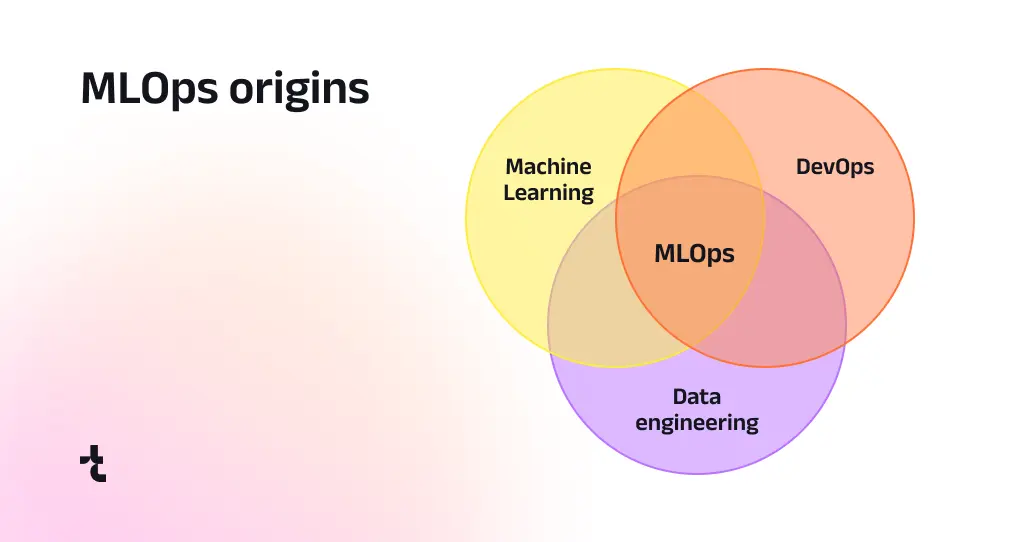MLOps vs. DevOps: Understanding the Differences & Choosing the Right Approach for AI Operations
February 28, 2025
Machine Learning Operations (MLOps) is more than just a set of tools or best practices—it’s an evolving discipline that brings structure, automation, and scalability to machine learning (ML) workflows. While DevOps transformed software development by enabling faster releases, higher reliability, and better collaboration, and DevSecOps integrated security as a core part of the development lifecycle, MLOps extends these principles to the unique challenges of ML model deployment and governance.
Unlike traditional software, machine learning models are data-dependent, dynamic, and require continuous monitoring to maintain accuracy over time. Challenges such as data drift, model degradation, and adversarial attacks make ML operations fundamentally different from traditional DevOps. Security concerns, including data privacy, model integrity, and compliance, bring DevSecOps principles into MLOps, ensuring that ML models are not only scalable but also secure and trustworthy.
In this article, we’ll explore the key differences between MLOps, DevOps, and DevSecOps, the challenges organizations face in adopting MLOps, and how integrating security and governance can accelerate AI development, improve model performance, and protect ML systems from vulnerabilities. Whether you’re coming from a software engineering background, cybersecurity, or data science, understanding this distinction is crucial for building a robust and secure AI-driven system.
What is DevOps?
DevOps is a set of practices that blends development and operations, aiming to foster collaboration and streamline the delivery of software products. At its core, DevOps encourages a shift from siloed team operations to cross-functional cooperation between developers, IT operations, and other key stakeholders within an organization.
In its most basic form, DevOps refers to the integration of automation, continuous integration, and continuous deployment to enable faster, more reliable software releases. It also encompasses a cultural transformation, where trust, communication, and shared responsibility between developers and operations teams become essential to the process.
Key Aspects of DevOps:
- Automation of repetitive tasks
- Continuous delivery and deployment
- Improved collaboration between development and operations
- Cultural changes promoting trust and transparency
Ultimately, DevOps enables organizations to align technology and business goals, transforming software delivery by enhancing efficiency, reducing errors, and accelerating time-to-market.
What are Machine Learning Operations (MLOps)?
MLOps, or machine learning operations, is a practice that brings together machine learning, data science, and operations. It aims to automate and improve the end-to-end machine learning lifecycle, from data preparation to model training, deployment, monitoring, and maintenance.
MLOps vs. AIOps vs. DataOps
MLOps, AIOps, and DataOps are crucial methodologies, each with distinct focuses on managing data and taking advantage of automation. Let’s explore how these methodologies differ in terms of their pipelines.
MLOps revolves around optimizing the lifecycle management of machine learning models, spanning from development to deployment and ongoing monitoring. Its pipeline typically includes:
- Data acquisition and preparation
- Model development and training
- Model evaluation and validation
- Model deployment
- Monitoring and support
AIOps use AI and machine learning to make operations faster, automate tasks, and improve system performance. Its pipeline encompasses:
- Data ingestion and processing
- Anomaly detection and root cause analysis
- Incident response and automation
- Continuous improvement and optimization
DataOps emphasizes collaboration, automation, and agility in managing data pipelines and workflows, focusing on accelerating insights delivery. Its pipeline comprises these stages:
- Data integration and ingestion
- Data preparation and quality assurance
- Model development and deployment
- Collaboration and governance
- Continuous integration and delivery
So, in essence, while MLOps specializes in managing machine learning models, AIOps focuses on enhancing operations through AI-driven insights, and DataOps emphasizes collaboration and automation in data management. Each methodology’s pipeline reflects its unique role in optimizing specific aspects of data-driven operations in the complex digital space.
How DevOps, AIOps, MLOps, and DataOps work together
These practices complement each other. For instance, AIOps, or DevOps and artificial intelligence, can enhance MLOps by providing advanced analytics to optimize machine learning models, while MLOps can benefit DataOps by maintaining data quality and accessibility for machine learning projects.
Key Differences Between MLOps vs DevOps
While DevOps and MLOps share a common goal of improving efficiency and collaboration within an organization, their focus and practices differ significantly. DevOps centers on streamlining the software development lifecycle, whereas MLOps is specifically designed to address the unique challenges associated with machine learning models.
In DevOps, the emphasis is on automating software development, deployment, and infrastructure management. It focuses heavily on improving collaboration between developers and IT operations teams to ensure faster, more reliable software releases.
On the other hand, MLOps goes a step further by incorporating machine learning workflows into the deployment and monitoring pipeline. It integrates data science and machine learning models into the process, requiring additional focus on model versioning, performance monitoring, and handling data-driven tasks.
To illustrate these differences more clearly, here’s a detailed comparison between DevOps and MLOps:
Focus
DevOps focuses on the integration of development and IT operations to streamline software development and deployment.
MLOps, on the other hand, focuses on the deployment, monitoring, and governance of machine learning models.
Primary Goal
The goal of DevOps is to accelerate software delivery and ensure continuous, reliable updates.
MLOps aims to automate and manage the entire machine learning lifecycle, from model development to deployment and continuous monitoring.
Automation
DevOps automates the processes of software development, testing, and deployment.
MLOps automates the training, deployment, monitoring, and updating of machine learning models.
Collaboration
DevOps encourages collaboration between developers, operations teams, and sometimes security professionals.
MLOps involves collaboration between data scientists, machine learning engineers, and DevOps teams.
Model/Code Deployment
In DevOps, the focus is on deploying applications and services.
MLOps focuses on the deployment and monitoring of machine learning models, including versioning and performance tracking.
Data Management
DevOps has minimal focus on data management.
MLOps, however, emphasizes managing data quality, version control, and datasets, which are critical for model accuracy.
Monitoring
DevOps primarily monitors the health and performance of applications.
MLOps extends this monitoring to the performance of machine learning models, detecting data drift and ensuring accuracy over time.
Version Control
In DevOps, version control is applied to code and configurations.
In MLOps, version control applies to code, models, and datasets, ensuring that changes are tracked throughout the model lifecycle.
Security
DevOps focuses on the security of the software and infrastructure, ensuring that deployments are secure and compliant.
MLOps adds a layer of security by ensuring the privacy and integrity of the models and data used, addressing concerns like data leaks and adversarial attacks.
Testing
DevOps tests the functionality and integration of software applications.
MLOps includes testing for model accuracy, validation, and performance in real-world conditions to ensure that models remain effective in production.
Tools
DevOps commonly uses tools such as Jenkins, Git, Docker, and Kubernetes for continuous integration and deployment.
MLOps leverages tools tailored for machine learning, including TensorFlow, PyTorch, Kubeflow, and MLflow, to manage the ML lifecycle.
As seen in the table above, while DevOps focuses primarily on application deployment and operational efficiency, MLOps introduces additional complexity related to model monitoring, data management, and performance tracking. Understanding these distinctions helps organizations choose the right approach and tools to optimize both software development and machine learning workflows.
How businesses use MLOps and what benefits they get
Machine learning in DevOps significantly refines the lifecycle of machine learning models. By automating processes and promoting collaboration among data scientists, engineers, and business stakeholders, MLOps enhances the efficiency of developing, deploying, and maintaining ML models.
For example, McKinsey reported that an Asian financial services company reduced the time to develop new AI applications by more than 50% by implementing a common data-model layer and standardizing data-management tooling and processes.
MLOps also preserves the quality and reliability of machine learning models by consolidating and automating processes. This approach reduces errors and makes sure that models perform as expected in real-world environments, such as tackling fraud risks in banking. MLOps enhances model auditability and responsiveness to change and provides a methodology for combining rapid feedback with automated monitoring to maintain model accuracy over time.
Companies using comprehensive MLOps practices shelve 30% fewer models and improve their AI model value by up to 60% (McKinsey).
As for people, MLOps frameworks empower data scientists by automating routine processes and allowing them to focus on higher-value tasks like adding new features to existing models and solving other business challenges.
MLOps optimizes costs and resources by improving model performance and polishing operational processes. By taking advantage of MLOps, organizations can manage machine learning consumption costs more effectively, ensuring resource-heavy analytics solutions are designed with cost considerations in mind.
Overall, implementing machine learning in DevOps delivers substantial business results, including cost savings, productivity gains, faster innovation, and improved model reliability. These examples and statistics demonstrate the transformative impact MLOps can have across different industries.
See how Timspark harnessed MLOps in Banking

Challenges of implementing MLOps solutions
Stakeholders sometimes view AI for DevOps as a miraculous solution for all issues, setting unfeasible goals, especially when non-technical stakeholders are involved. However, it doesn’t stop here. Take a minute to review the most common DevOps and machine learning implementation challenges and how to tackle them effectively.
Challenge | Solutions |
Unrealistic expectations | - Set clear, realistic goals and expectations with all stakeholders. |
Data management | - Centralize data storage and implement shared mappings across teams. |
Security | - Adopt software that provides security patching and support. |
Inefficient tools and infrastructure | - Seek budgets for virtual hardware subscriptions like AWS or IBM Bluemix. |
Lack of communication and user engagement | - Engage with users early in the process. |
Technical and operational issues | - Develop expertise in Kubernetes and containerization. |
Using machine learning inappropriately | Evaluate the need for an ML solution; consider simpler, rule-based systems when appropriate. |
Integration with business systems | - Consider the downstream application of ML models at the start. |
Feature management and operational challenges | - Use scalable and production-ready data-science platforms from day one. |
At Timspark, we guide organizations through these challenges, offering tailored solutions that align with business objectives and technical requirements.
We help:
- Set realistic goals
- Improve data management
- Enhance security
- Upgrade tools and infrastructure
- Facilitate better communication and user engagement
- Provide technical and operational support
- Ensure the appropriate use of ML
- Integrate ML models with business systems
Consider MLOps in pursuit of competitive advantage
The incorporation of DevOps methodologies into AI and machine learning represents more than just a passing trend; it’s an essential progression to meet the growing complexity and demands of technology. The implementation of machine learning in DevOps and its associated practices offers businesses the opportunity to achieve greater efficiency, innovation, and competitive edge. As technology advances, the application of these principles will also evolve, heralding promising advancements in the future.
Should you be considering the integration of DevOps and machine learning into your workflows but find yourself facing one or more challenges, don’t hesitate to get in touch and seek comprehensive support throughout the process.


